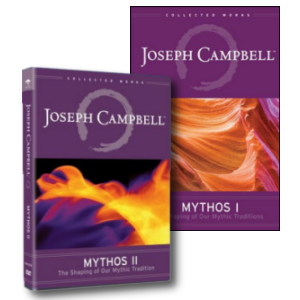
A hero is a real person or a main fictional character who, in the face of danger, combats adversity through feats of ingenuity, courage, or strength. The original hero type of classical epics did such things for the sake of glory and honor. Post-classical and modern heroes, on the other hand, perform great deeds or selfless acts for the common good instead of the classical goal of wealth, pride, and fame. The antonym of hero is villain. Other terms associated with the concept of hero may include good guy or white hat.

Joseph John Campbell was an American writer. He was a professor of literature at Sarah Lawrence College who worked in comparative mythology and comparative religion. His work covers many aspects of the human experience. Campbell's best-known work is his book The Hero with a Thousand Faces (1949), in which he discusses his theory of the journey of the archetypal hero shared by world mythologies, termed the monomyth.
Religion and mythology differ in scope but have overlapping aspects. Both are systems of concepts that are of high importance to a certain community, making statements concerning the supernatural or sacred. Generally, mythology is considered one component or aspect of religion. Religion is the broader term: besides mythological aspects, it includes aspects of ritual, morality, theology, and mystical experience. A given mythology is almost always associated with a certain religion such as Greek mythology with Ancient Greek religion. Disconnected from its religious system, a myth may lose its immediate relevance to the community and evolve—away from sacred importance—into a legend or folktale.

A narrative, story, or tale is any account of a series of related events or experiences, whether nonfictional or fictional. Narratives can be presented through a sequence of written or spoken words, through still or moving images, or through any combination of these. The word derives from the Latin verb narrare, which is derived from the adjective gnarus. The formal and literary process of constructing a narrative—narration—is one of the four traditional rhetorical modes of discourse, along with argumentation, description, and exposition. This is a somewhat distinct usage from narration in the narrower sense of a commentary used to convey any written narrative. Many additional narrative techniques, particularly literary ones, are used to build and enhance any given story.

The Hero with a Thousand Faces is a work of comparative mythology by Joseph Campbell, in which the author discusses his theory of the mythological structure of the journey of the archetypal hero found in world myths.

The Power of Myth is a book based on the 1988 PBS documentary Joseph Campbell and the Power of Myth. The documentary was originally broadcast as six one-hour conversations between mythologist Joseph Campbell (1904–1987) and journalist Bill Moyers. It remains one of the most popular series in the history of American public television.
Mythopoeia, or mythopoesis, is a narrative genre in modern literature and film where an artificial or fictionalized mythology is created by the writer of prose, poetry, or other literary forms. The concept was introduced by J. R. R. Tolkien in the 1930s. The authors in this genre integrate traditional mythological themes and archetypes into fiction. Mythopoeia is also the act of creating a mythology.

In narratology and comparative mythology, the hero's journey, or the monomyth, is the common template of stories that involve a hero who goes on an adventure, is victorious in a decisive crisis, and comes home changed or transformed.
Comparative mythology is the comparison of myths from different cultures in an attempt to identify shared themes and characteristics. Comparative mythology has served a variety of academic purposes. For example, scholars have used the relationships between different myths to trace the development of religions and cultures, to propose common origins for myths from different cultures, and to support various psychoanalytical theories.

Mythos is a three-part documentary that consists of a series of lectures given by Joseph Campbell. Campbell conceived of the original lectures, filmed over the last six years of his life, as a summation of what he had learned about the human mythic impulse, in terms of psychology, ethnology and comparative mythology—what he called "the one great story of mankind."
The genesis of modern understanding of Greek mythology is regarded by some scholars as a double reaction at the end of the 18th century against "the traditional attitude of Christian animosity mixed with disdain, which had prevailed for centuries", in which the Christian reinterpretation of myth as a "lie" or fable had been retained. In Germany, by about 1795, there was a growing interest in Homer and Greek mythology. In Göttingen Johann Matthias Gesner began to revive Greek studies and a new humanistic spirit. His successor, Christian Gottlob Heyne, worked with Johann Joachim Winckelmann, and laid the foundations for mythological research both in Germany and elsewhere. Heyne approached the myth as a philologist and shaped the educated Germans' conception of antiquity for nearly half a century, during which ancient Greece exerted an intense influence on intellectual life in Germany.
Jungian archetypes are a concept from psychology that refers to a universal, inherited idea, pattern of thought, or image that is present in the collective unconscious of all human beings. The psychic counterpart of instinct, archetypes are thought to be the basis of many of the common themes and symbols that appear in stories, myths, and dreams across different cultures and societies. Some examples of archetypes include those of the mother, the child, the trickster, and the flood, among others. The concept of the collective unconscious was first proposed by Carl Jung, a Swiss psychiatrist and psychoanalyst.

Jewish mythology is the body of myths associated with Judaism. Elements of Jewish mythology have had a profound influence on Christian mythology and on Islamic mythology, as well as on Abrahamic culture in general. Christian mythology directly inherited many of the narratives from the Jewish people, sharing in common the narratives from the Old Testament. Islamic mythology also shares many of the same stories; for instance, a creation-account spaced out over six periods, the legend of Abraham, the stories of Moses and the Israelites, and many more.
An origin myth is a type of myth that explains the beginnings of a natural or social aspect of the world. One specific kind of origin myth is the creation or cosmogonic myth, which narrates the formation of the universe. However, numerous cultures have stories that take place after the initial origin. These stories aim to explain the origins of natural phenomena or human institutions within an already existing world. In Graeco-Roman scholarship, the terms etiological myth and aition are occasionally used to describe a myth that clarifies an origin, particularly how an object or custom came into existence.

In mythology and the study of folklore and religion, a trickster is a character in a story who exhibits a great degree of intellect or secret knowledge and uses it to play tricks or otherwise disobey normal rules and defy conventional behavior.

The Historical Atlas of World Mythology is a multi-volume series of books by Joseph Campbell that traces developments in humankind's mythological symbols and stories from pre-history forward.
Personal mythology refers to an individual's fundamental stories for making sense and meaning of the world. According to Dr. David Feinstein and Dr. Stanley Krippner, "A personal myth is a constellation of beliefs, feelings, images, and rules—operating largely outside of conscious awareness—that interprets sensations, constructs new explanations, and directs behavior. ...Personal myths speak to the broad concerns of identity, direction, and purpose. For an internal system of images, narratives, and emotions to be called a personal myth, it must address at least one of the core concerns of human existence."

Roman mythology is the body of myths of ancient Rome as represented in the literature and visual arts of the Romans. One of a wide variety of genres of Roman folklore, Roman mythology may also refer to the modern study of these representations, and to the subject matter as represented in the literature and art of other cultures in any period. Roman mythology draws from the mythology of the Italic peoples and ultimately from Proto-Indo-European mythology.
Stanley Keleman was an American writer and therapist, who created the body psychotherapy approach known as "formative psychology". He was one of the leaders of the body psychotherapy movement nationally and internationally. His methodology rested on an anatomical base and incorporates an evolutionary, philosophical and mythological perspective; within this formative paradigm the human is capable of learning voluntary self-influence of instinctual and emotional expression as a way to manage dilemmas of daily living and to form personal choices for creating a future. Keleman started developing and articulating his concepts in 1957. In 1971, he published the first of 10 books.
Robert S. Ellwood is an American academic, author and expert on world religions.











